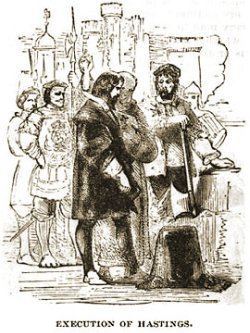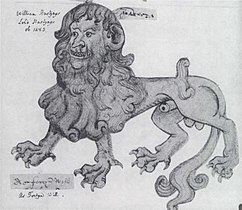Noble family Hastings Father Sir Leonard Hastings | Mother Alice Camoys Name William 1st | |
 | ||
Books How to Think about Social Problems: A Primer for Citizens Children Edward Hastings, 2nd Baron Hastings, Anne Hastings, Countess of Shrewsbury Grandchildren George Hastings, 1st Earl of Huntingdon, Francis Talbot, 5th Earl of Shrewsbury Similar People Richard Neville - 16th Earl, Edward V of England, Richard III of England, Cecily Bonville - 7th Baron, Henry VI of England | ||
William Hastings, 1st Baron Hastings KG (c. 1431 – 13 June 1483) was an English nobleman. A loyal follower of the House of York during the Wars of the Roses, he became a close friend and one of the most important courtiers of King Edward IV, whom he served as Lord Chamberlain. At the time of Edward's death he was one of the most powerful and richest men in England. He was summarily executed following accusations of treason by Edward's brother and ultimate successor, Richard III.
Contents

Biography
William Hastings, born about 1431, was the eldest son of Sir Leonard Hastings (c.1396 – 20 October 1455), and his wife Alice Camoys, daughter of Thomas de Camoys, 1st Baron Camoys. Hastings succeeded his father in service to the House of York and through this service became close to his distant cousin the future Edward IV, whom he was to serve loyally all his life. He was High Sheriff of Warwickshire and High Sheriff of Leicestershire in 1455.
He fought alongside Edward at the Battle of Mortimer's Cross and was present at the proclamation of Edward as king in London on 4 March 1461 and then when the new king secured his crown at the Battle of Towton shortly thereafter. He was knighted on the field of battle. With the establishment of the Yorkist regime, Hastings became one of the key figures in the realm, most importantly as Master of the Mint and Lord Chamberlain, an office he held for the duration of the reign and which made him one of the most important means of access to the king. He was also created Baron Hastings, a title reinforced by grants of land and office, primarily in Leicestershire and Northamptonshire. In 1462 he was invested as a Knight of the Garter.
In 1474, he was awarded royal licence to crenellate at three of his landholdings in Leicestershire; at Ashby-de-la-Zouch, Kirby Muxloe, and at Bagworth. He built extensively at Ashby, mostly making additions to the pre-existing manor house built by the de la Zouch family in the thirteenth century. His greatest achievement at Ashby was the Hastings Tower. At Kirby Muxloe Castle he began an intricate fortified house of red brick, one of the first of its kind in the county. Thanks to English Heritage, the castles at Ashby and Kirby can still be seen, but nothing survives to indicate any construction at Bagworth.
His importance in these years is recorded in a number of sources and was recognised by the greatest peer in the realm, Richard Neville, Earl of Warwick. In 1462, Warwick arranged for Hastings to marry his widowed sister, Katherine Neville. (Katherine's first husband, Lord Bonville, had been killed at St Albans in 1461; their infant daughter, Cecily, succeeded to the Bonville titles and estates.)
Despite this matrimonial relationship with the Nevilles, when Warwick drove Edward IV into exile in 1470, Hastings went with Edward and accompanied the king back the following spring. Hastings raised troops for Edward in the English Midlands and served as one of the leading captains of the Yorkist forces at both Barnet and Tewkesbury.
His service, loyalty and ability, along with the fall of his Neville in-laws, made Hastings even more important during the second half of Edward IV's reign. He continued to serve as Chamberlain and was awarded the position of Chamberlain of the Exchequer in 1471, which he held until 1483. He was also appointed Lieutenant of Calais, which made him an important player in foreign affairs, and given authority over an increasingly large section of the English Midlands. At court, he was involved in two lengthy feuds with members of Queen Elizabeth Woodville's family, most notably with her son Thomas Grey, first Marquess of Dorset.
Death
After the death of Edward IV on 9 April 1483, the Dowager Queen appointed family members to key positions and rushed to expedite the coronation of her young son Edward V as king, circumventing Richard, Duke of Gloucester, whom the late king had appointed Lord Protector. Hastings, who had long been friendly with Richard and hostile to the Woodvilles, was a key figure in checking these manoeuvres. While keeping the Woodvilles in check in London, Hastings informed Richard of their proceedings and asked him to hasten to London. Richard intercepted the young king, who was on his way to London, with his Woodville relatives. Hastings then supported Richard's formal installation as Lord Protector and collaborated with him in the royal council.
Affairs changed dramatically on 13 June 1483 during a council meeting at the Tower of London: Richard, supported by the Duke of Buckingham, accused Hastings and two other council members of having committed treason by conspiring against his life with the Woodvilles, with Hastings's mistress Jane Shore (formerly also mistress to Edward IV and possibly Dorset), acting as a go-between. While the other alleged conspirators were imprisoned, Hastings was immediately beheaded on Richard's orders over a log in the courtyard of the Tower.
The summary execution of the popular Hastings was controversial among contemporaries and has been interpreted differently by historians and other authors. The traditional account, harking back to authors of the Tudor period, including William Shakespeare, considered the conspiracy charge invented and merely a convenient excuse to remove Hastings, who was known for his loyalty to the dead king and his heirs, as while he remained alive he would have been too formidable an obstacle to Richard's own plans to seize the throne. Others have been more open to the possibility of such a conspiracy and that Richard merely reacted to secure his position.
Despite the accusations of treason, Richard did not issue an attainder against Hastings and his family. Hence, his wife and sons were allowed to inherit his lands and properties. Hastings was buried in the north aisle of St George's Chapel, Windsor, next to Edward IV.
In literature
He is portrayed in two of Shakespeare's plays: Henry VI, Part 3 and Richard III.
Family
Hastings married, before 6 February 1462, Katherine Neville, sister of Richard Neville, Earl of Warwick, known as "Warwick the Kingmaker," and widow of William Bonville, 6th Baron Harington, slain at the Battle of Wakefield on 30 December 1460, by whom he had had four sons and two daughters:
